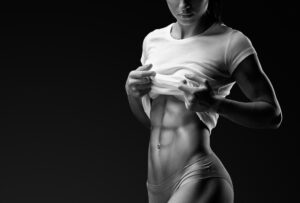 Have you seen those liposuction cases where they turn a guy from a beer belly into a six pack? How did they do it? Well this is called “high definition liposuction,” and what they are essentially doing is sculpting the fat to look like abdominal muscles.
Have you seen those liposuction cases where they turn a guy from a beer belly into a six pack? How did they do it? Well this is called “high definition liposuction,” and what they are essentially doing is sculpting the fat to look like abdominal muscles.
I have to say, the initial talks I saw on this years ago were not too impressive. I thought it looked fake or odd, so I didn’t give it much credence. But techniques have evolved, and at this meeting I saw a talk by one of the masters, Dr. Tasmin. His results were impressive. One thing he emphasized is for men (they tend to be the ones he operated on to do this), you should not do the liposuction etching to make a sculpted six pack of abdominal muscles unless you have a good regimen in place. He stated “this is a TURNING POINT in your life.”
So what did he do?
- His marking technique was impressive. I love our new technology at these presentations, so now when people give talks they have videos and all sorts of aids, so we can see exactly what they are doing. I have done liposuction for 25 years. I know liposuction well. What we are learning at conferences is the nuances, the tiny pearls of wisdom from someone who focuses on a certain thing. For this speaker, he is all about sculpting men’s muscles. He spends a lot of time marking his patients, and marks the muscle edges seen with movement and different positions. I think how he thinks about male liposuction is important. He focuses on the pectoral area, the abdominal six pack, and the flanks. He is thoughtful about the ideal male body shape. For most women, the goal is volume removal and smooth curves. I have this conversation with women all the time, as liposuction is sculpting. For men, removing all the fat is not the case. He strategically wants to leave fat behind to create the illusion of more defined musculature.
- He used different equipment of liposuction: ultrasonic and microaire. He removed the deep fat and sculpted the superficial fat. He used cannula sizes larger than what I traditionally use (He used 4mm or even a 5mm). He stated, “the technique is more important.”
- The six pack is not of muscle. “This is not a six pack, it is ‘six FAT’.” Historically this fact has turned me off- what does it feel like? Won’t we know it isn’t muscle? But he states especially in men, when you touch it, it feels fibrous, so it feels like muscle. He doesn’t leave this sculpted superficial fat layer too thick. You need to reduce the superficial fat to 2cm in thickness.
- Men tend to have good skin retraction. In some women with poor skin tone or “skin redundancy,” he used renuvion. He did not share many photos of women, so I cannot speak to those results.
- To do this takes more time. His time is around 3 hours for one side. (chest/abd or back).
- How big can you be? He operates on patients with BMI of 30, but suggests it is best on patients BMI 27 or less.
- How do these patients age with time? If patients gain weight, they see the definition go away. But when they re-lost the weight, the definition came back.
- How does this do with aging of skin? “I don’t know.” They haven’t been doing this procedure for 10 years yet.
- When you are going so superficial, do you see staining in the skin- red “Hemosiderin staining” or hyperpigmentation? The answer is you can. He suggested to inject tumnescent into the superficial layer. There is no treatment if pigmentation occurs. It tends to improve over time.
- Does your skin color affect your results? We gauge skin color on the Fitzpatrick score: The higher the skin score, the darker your skin. Does a higher score have better the skin retraction? He said it isn’t based on skin color. Some people have better connective tissue, so they will have better skin retraction. This is an issue of the quality of your connective tissue. Men tend to retract better than women in general.
So what do I think?
The results looked impressive in the photographs. I would like to see it live to see how natural it looks when people move. I would like to touch it to see if it really does feel like muscle and not fat. I would like to see how the skin tone reacts, as the skin “shrinking” to fit the smaller size is important. For women, skin laxity (especially after kids, aging, and menopause) is a real issue.
But I think I will forevermore look at male liposuction differently. How someone wants to look after, how defined they want their muscles to look, is a conversation I need to have with my male patients. I do believe liposuction is an art. Sculpting is involved. I have conversations with my female patients all the time about how aggressive they want me to be, what bothers them, and where I will be doing the removal and shaping. I need to have a more detailed discussion of this with men as well.
The information provided on this website is for general informational purposes only and does not constitute medical advice, diagnosis, or treatment. Always seek the advice of a qualified healthcare provider for any questions regarding your health or medical condition.
